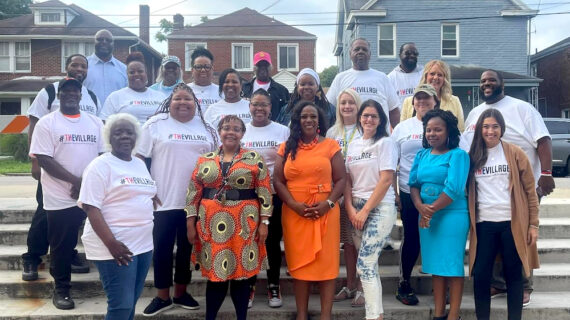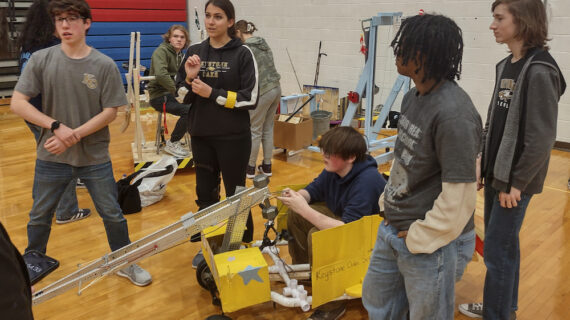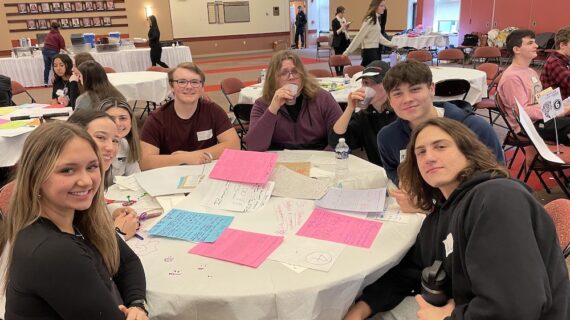
Accelerating relationships in the Avonworth School District
This story is one in a series created in collaboration with the AASA Learning 2025 Alliance to celebrate the work of groundbreaking school districts in the Pittsburgh region. Kidsburgh will share these stories throughout 2024.
Whenever Principal Mike Hall began a new school year, he’d ask the students at Avonworth Middle School one question: Who in this building is your go-to adult?
Often, students would name their favorite teacher. But sometimes, Hall says, “their answer was that they didn’t have any adult at all. And you hate to hear that.”
At nearby Avonworth Elementary, Principal Bill Battistone shared a similar concern. “One of the things I was always hyper-aware of was that as a third grader, you might have a great connection with your third-grade teacher,” he says. “But after third grade, you might not interact with that teacher ever again. What happens to that relationship?”
It’s a question that school districts everywhere are asking. Nationally, surveys show that less than 1 in 4 students feel connected to a teacher — a troubling statistic, given that caring relationships have been linked to higher test scores, lower absenteeism, and better mental health. Relationships are so important, in fact, that many educators consider them key to reversing learning loss and solving other post-pandemic problems.
“To say it very simply,” says Jeff Hadley, Avonworth’s superintendent, “we know that kids learn better when they’re healthy and cared for.”
It’s a belief shared across the Avonworth School District.

Among the dozens of stakeholders who shaped its strategic plan — including parents, community members, board members, and students — there was wide agreement that the district needed “some type of program in each building that would help us wrap our arms around students,” Hadley explains. “Because those connections are essentially a form of protection: When kids and adults connect on a regular basis, we’re able to catch problems and offer support much more quickly.”
Avonworth isn’t alone in its quest to nurture connections. It’s also part of the Western Pennsylvania Learning 2025 Alliance, a regional cohort of school districts working together — with support from The Grable Foundation — to create student-centered, equity-focused, future-driven schools. Led by local superintendents and AASA, The School Superintendents Association, the Alliance convenes to help districts like Avonworth do what they do best: prepare every learner for tomorrow.
“Any time we can work with our colleagues from around the region or across the nation, we gain something,” Hadley says. The Alliance “puts us in a room with superintendents and educators who are doing all kinds of incredible things for kids. And learning together helps us accelerate the changes we’re aiming to make in our districts.”
In Avonworth, that means accelerating relationships.
Enter Bridges, the advisory program at Avonworth Elementary. Comprising 11 groups of about 50 students each — and led by Avonworth’s teachers, paraprofessionals, custodians, and others — each “Bridge” takes its name from a famous bridge around the world, from the Rachel Carson Bridge in Pittsburgh to the Sydney Harbour Bridge in Australia.
The groups have their own customized t-shirts; they make up their own slogans and chants. And once a month, on “Bridge Day,” the groups meet for activities, projects, and fun — building new, lasting relationships across the entire building.
“We don’t change Bridges,” Battistone says. “Once you’re assigned to a Bridge, you stay with the same group for the next few years. And that’s helped us create longitudinal relationships across grade levels and with adults whom kids might not otherwise get the opportunity to interact.”
The effects, he adds, “have been unbelievably positive.” Each Bridge Day ends with a school-wide assembly in the gym, where students who embody values like kindness and empathy are recognized in front of their peers. The Bridge with the most individual recognitions earns an extra recess.
“What I love about the assemblies is that all of the kids are cheering, no matter which Bridge wins,” says Hadley. “They create this amazing sense of community. All it takes is two hours once a month, but the positivity lasts well beyond Bridge Day. A third grader might make a new connection with a fifth grader. Or a fourth grader might give the secretary a high-five. It creates a lot of camaraderie in the building.”
And it’s not just the elementary school. At Avonworth Middle, a program called Connections is doing something similar. Every teacher begins the school year by telling students about their go-to adult — the person who had a positive impact on them while they were middle school students themselves. Then, each student lists a few teachers with whom they’d like to form a connection, and they’re assigned to groups accordingly. Every Friday, in groups of about 15 students, they meet with that teacher during a Connections period.
“It’s very informal,” explains Hall. “It’s not graded or anything like that. Usually, they start off with a discussion question — it can be as simple as ‘What’s your favorite ice cream?’ or as deep as ‘What does belonging mean to you?’”
The ensuing discussions — and Connections’ built-in time for simply hanging out and having fun — help build the relationships that matter so much. And they ensure that “every student in the middle school finds a go-to adult,” says Hall.
The district isn’t stopping there — it’s also reimagining advisory programs for its primary school and its high school. “Regardless of grade level, we know students need similar things,” says Hadley. “They need to feel safe. They need to feel seen. And they need to know that the people around them are there for their success.”
And at Avonworth, “That’s exactly what we’re aiming to show them.”
Want to download this story? Click here for a PDF.











